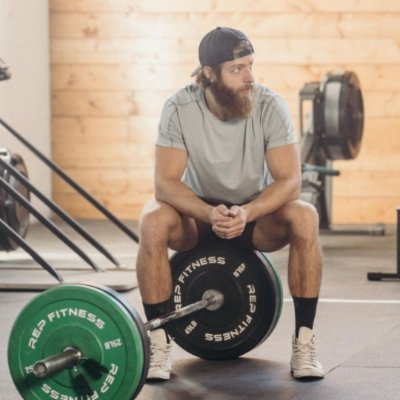When you have long legs the name of the game is paying attention to your exercise setup, the range of motion you’re training through, and picking exercises that allow you to train at high intensities.
The act of building big and strong legs is no easy feat. I’ve been trying to build my legs for years and it’s not always the easiest goal since I have fairly long femurs and shins.
To be quite honest with you, I’m regularly self-conscious about my leg size but I’m working on it (hey, we all have our things, right?). When tackling leg day, I’ve learned to be strategic with my exercise selection to get the most out of my sessions.
If you have long legs, hopefully, this article can give you some nice quad-building options to start using for your workouts.
1. Quad-Biased Walking Lunge
The first exercise that I love using for building my quads is a quad-biased walking lunge. To be honest, it took me multiple years to figure out how well my body responds to this exercise.
Why They Can Be Great
When performing quad-biased walking lunges, the name of the game is getting the knees to track further over the toes than what they would do when performing a traditional lunge.
In a walking lunge, we’re moving through a fairly large range of motion to begin with, and by further biasing the quads we get an awesome stimulus from both a lengthened and shortened context.
Additionally, a walking lunge’s stability element can be fantastic for recruiting more muscles for stability purposes and for adding a coordination and balance component to our training. It’s a win-win.
How To Do Quad-Biased Walking Lunges
To bias the quads in your walking lunge you’ll want to try and do two things. First, if you’re not changing shoes you’ll want to cue more knee tracking, so essentially, when moving through the eccentric you’ll want to think stay over the forefoot and push the knee forward.
Second, if you find that difficult to do, you’re a beginner, or you have limited ankle mobility, then opting for a pair of weightlifting shoes while performing these can be a foolproof way to get more knee tracking.
- Grab your weight and step into your first rep.
- As your foot hits the ground, think about staying over the front leg a little more than normal and “push” the knee forward while keeping the foot planted.
- It can be useful to cue “find your big toe” when working to stay into and over the quads.
- As you hit your end range of motion, drive the forefoot into the ground to create extension at the knee then repeat this process for your following reps.
This is an exercise that may take a few sessions to fine-tune, but once you find your rhythm with these, I’d suggest giving it a few weeks to see how you respond. Say consistent and load accordingly.
2. Bulgarian Split Squat With Heel Elevation
Another exercise that has been fantastic for building my quads is the Bulgarian split squat but a heel elevation. This elevation can promote a greater quad bias while performing this exercise.
Why They Can Be Great
We all love to hate Bulgarian split squats because they can feel like punishment at times. In the context of the quads, the Bulgarian split squat is already great for targeting the quads but when you elevate the heel you create an ever bigger bias.
With an elevated heel, we’re putting our foot and ankle into an environment that can feed better into forward knee translation. In layman’s terms, it can make it easier for us to get the knees to track more without changing too much.
How To Do Quad-Biased Bulgarian Split Squats
Similar to the walking lunge variation above, you’ll want to elevate the heel using a wedge, plate, or pair of weightlifting shoes. Typically, I suggest lifters opt for wedges and weightlifting shoes as they give you more surface area with the feet.
When sequencing this exercise, you’ll want to bring your stance in a little bit and focus on keeping a majority of your weight over your front leg to ensure you’re loading the quads as much as possible.
- Set up on a bench or a lower surface if you have limited hip mobility.
- Grab your weight and descend thinking about “staying over” the front leg and driving the knee over the toes.
- As you hit your end range of motion, find your big and drive through the forefoot.
Pro Tip: I like to add a dowel or support to my quad-biased Bulgarian split squats when I want to increase stability to focus on tempo and things like adding more hip internal rotation.
3. Quad-Biased Leg Press
The leg press is great for building and strengthening the legs in general, but by manipulating your foot position and hitting quad-biased leg presses you can further bias the muscles you’re trying to build.
Why They Can Be Great
Quad-biased leg presses can be fantastic because you have an added level of stability when performing them which is useful for pushing more volume at higher intensities.
Free weight exercises like a high-bar squat can be great for building the quads, but if you’re already fatigued or you’re trying to limit how much axial loading (spinal loading) you’re doing, then a quad-biased walking lunge can make a lot of sense.
I also like quad-biased walking lunges because they can be easy to teach and implement at all skill levels. If you’re wanting to learn how to “bias the quads” for different exercises, this variation can be a useful tool for teaching you mechanic principles to seek out.
How To Do Quad-Biased Leg Presses
To properly perform quad-biased leg press, a lot of it comes down to your stance and foot position. Unlike a traditional leg press, you’ll want to bring your feet down a little on the platform and keep them around hip-width to just wider apart.
The goal here is getting the knees to track further and if we bring the feet down on the platform then we can generally get a greater stretch on the quads.
- Set up like you normally would on your leg press machine.
- Bring your feet down on the platform and keep your toes forward or turned out slightly. Do whatever is most comfortable.
- Lower the leg press to a point at which you start to feel your heel come off the platform. Stop shy before it physically lifts off then press the weight.
A pair of weightlifting shoes can be awesome for getting more out of your quad-biased leg presses. Not every leg press is built well and weightlifting shoes can be great for helping you achieve better positions and mechanics.
4. Sissy Squats
It’s tough to beat sissy squats when the goal is lengthening and targeting the quads. If you’ve never performed this exercise then it may look odd at first, but they can be great for lifters from all walks of life.
Why They Can Be Great
Sissy squats can be exceptionally great for training the quads through an extremely lengthened position. In addition, sissy squats can be great for strengthening the tissues around the knee as well.
With this variation, you’ll typically want to use a constraint and support and by doing so you can easily modify their intensity and range of motion. This makes them great for lifters dealing with cranky knees and for lifters wanting to strengthen connective tissues.
There’s also the benefit of being able to perform these pretty much anywhere. Sissy squats are a quad-training staple of mine when I’m working out while traveling.
How To Do Sissy Squats
If you’ve never performed sissy squats, then I’d suggest holding onto a squat rack or wall to feel this exercise out. In addition, you may want to limit “how much” you’re up on your toes to ensure you understand the mechanics of this exercise.
- Holding onto a constraint, bring your feet about hip-width apart and come up on your toes.
- Descend down thinking about keeping the hips tracking vertically and letting the knees travel over the toes.
- As you hit your end range of motion, keep driving the forefeet into the ground and stand up squeezing the quads throughout.
Don’t be afraid to also shorten the range of motion you’re working through and build up to full ROM as you acclimate to this exercise and give your knee tissues time to adjust.
5 & 6 (Superset): Leg Extension and ISO Bulgarian Split Squat
The next two exercises are great when paired together in a superset. I’ll typically do these two as finishers when I’m trying to absolutely bury my quads for the day or when I have limited equipment in hotels.
Why These Can Be Great
The pairing of a leg extension with an ISO Bulgarian split squat is awesome because you’re essentially training the quads heavily through a shortened biased exercise (leg extension) and then through a lengthened exercise (Bulgarian split squat).
By doing this, we can somewhat hedge our bets regarding hitting the quads to their entirety. I also like this pairing because these exercises don’t require a ton of skill which is why I’ll use them later in a workout when I’m already gassed.
For beginners, this pairing can also be great because it can give you more practice playing with supersets and getting as much out of them as possible. Low-skill exercises that can be performed for high volumes are always great for hypertrophy-focused supersets.
How To Do This Superset
To get the most out of this superset the devil’s in the programming details. Personally, I’ll perform the leg extension set for higher reps between 10-15 and add a 1-2 sec pause at the top to get a ton out of the shortened and contracted quads.
For the ISO Bulgarian split squat, I’ll focus on “sitting” into the back leg a little bit to get a nice stretch across the quads and I’ll perform 1-2 holds for 20-30 seconds.
- Set up in a leg extension. Make sure the back of the seat is either flush with the back of your knee or you have a little space between the back of the knee and the pad when in the bottom range of motion.
- Grab onto the seat’s handles and anchor yourself down while kicking up and initiating your movement with the quads.
- Squeeze once you hit full extension and repeat this.
- Rest 5-10 seconds.
- Set up for a traditional Bulgarian split squat and descend into a rep.
- Stop just shy of your full range of motion and actively hold this position. Don’t just sit into the hole. Actively hold a position.
- Drive the front leg down and lengthen the back leg’s quad with intent.
- Hold for 20-30 seconds.
Don’t be afraid to play with different setups, sets, reps, and times with this superset. You’ll want to scale it based on your needs and capabilities and its dealer’s choice regarding what gives you the most bang for your buck.
Frequently Asked Questions (FAQ)
Q:How do you train your legs with long legs?
Q:Is it harder to build muscle on long legs?
Q:Is squatting harder if you have long legs?
Takeaway Thoughts
To my fellow long-legged friend, we have gains to be made. If you’re trying to build your quads and you have long legs then all you need is a little strategy.
By selecting better exercises and modifying them slightly to better support your anatomy and needs you can make greater strides than constantly trying to fit square pegs into round holes.
If you have additional questions about this article or have exercises YOU love that you’ve seen awesome progress with, drop a comment below.


















Add a Comment